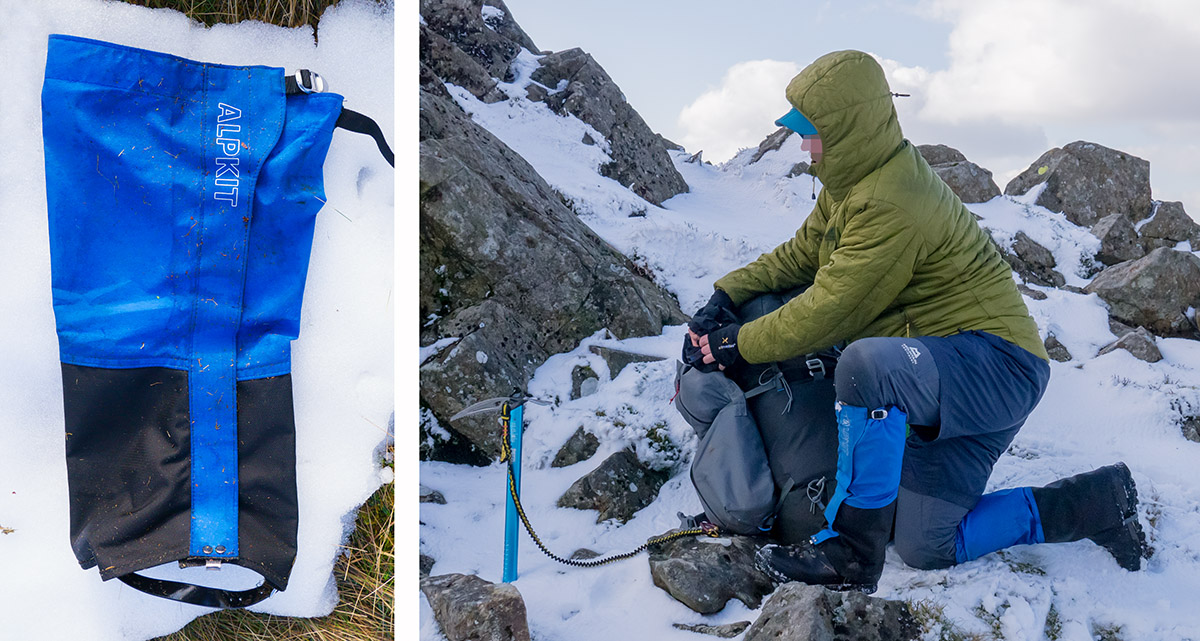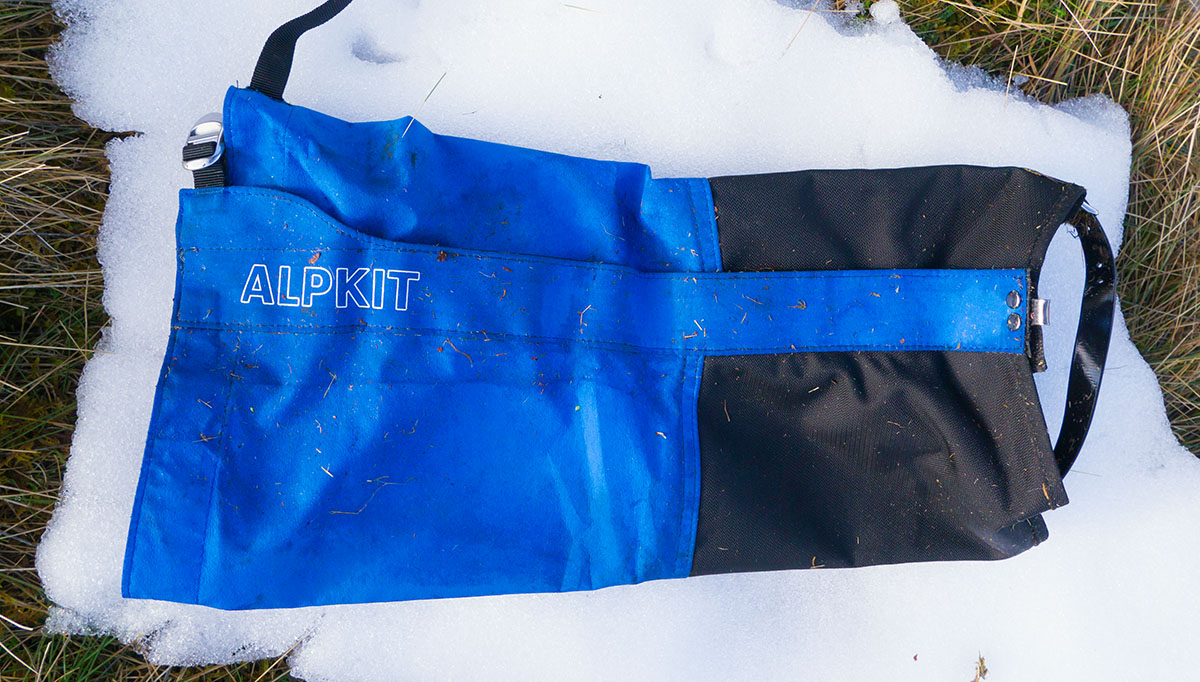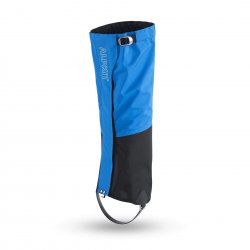Alpkit's Colca Hiking Gaiters
Preface
As always, we're looking at the Alpkit Colca Gaiters from the point of view of long distance trekking over tough terrain.
Test subject: Height: 5ft 8", Inside Leg = 30", Boot Size = 9 Medium
Test item: Size = M/L, Colour = Lego
Kit Tests: Winter
Disclaimer: None required (item not provided by manufacturer)
Datasheet
| Materials (Upper): 50D 3L Waterproof Nylon (5000 HH, 5000 MVTR) | 100% |
| Materials (Lower): 420D PU Coated Ballistic Cordura | 100% |
| Underfoot Strap (Buckle = Stainless Steel): | 15mm TPU |
| Closure: Velcro + Stainless Steel Lace Hook | - |
| Weight (Size M/L, stated / measured) | 212g / 208g |
| Product Sizing Reference: 30" Inside Leg = | M/L |
| Manufacturer RRP | £29.99 |
Scramble Review
Gaiters: A Spanner in the Works
Gaiters are one of those items that seem to divide opinion. In my mind, it really boils down to whether you carry crampons and are willing to engage in some winter scrambling. I'll sometimes take a reasonably direct route to access a ridge and so in winter I carry crampons and an ice axe. Clambering up these awkward obstacles (pictured below) in the 2020 kit test would have shredded most waterproof overtrousers and this is where a tough pair of gaiters can be a superior option.
 Where waterproof over-trousers go to die
Where waterproof over-trousers go to die
I've been getting more and more use out of my custom waterproof shorts (and not just in summer, for which they were originally made). For the bulk of this year's wet, cold and very stormy winter kit test I used the legwear combo pictured above (I'm also noticing my "waterproof short evangelism" is beginning to gain acceptance among some of my Scramble team members).
The excellent Alpkit Colca Gaiters reviewed here, in combination with waterproof over-shorts and a tough pair of softshell trousers (Mountain Equipment's Ibex) worked so well it's left me questioning whether full length waterproof trousers are really necessary (this issue is covered in more depth in the ME Ibex review).
Gaiters provide waterproof protection up to the knee and waterproof shorts do the same above the knee, allowing the exposed, much tougher softshell fabric of the winter trousers to deal with the rock and scree. The gaiters protect against the rain, snow and crampon spikes, while the waterproof shorts keep everything above the knee dry.
In stormy, downpour conditions, I still think you need something to cover the knees, since if they get drenched, that water will eventually seap into the socks and then down inside the boot. Some in the UL community swear by their "rain skirts" or "rain kilts" (Zpack's Dyneema version is pictured right); I'm not sure Scramble will go that far (I for one have been blown off my feet too many times to add a sail between my legs and I've not heard any murmurings from my team members promoting the kilt) but I see no reason why an UL 3/4 length ("capri") waterproof overtrouser (in the 120g range) for emergency downpour use, couldn't replace traditional waterproofs when using knee length gaiters. We're getting some pairs made up as I write this and it's something I'm looking forward to testing.
So, a combination of re-thinking our approach to winter trousers, the introduction of waterproof shorts and the experience of using Alpkit's excellent Colca gaiters has kind of thrown a spanner in the legwear works. The resolution to this conundrum has resulted in another (somewhat unconventional) modular approach and a concomitant bifurcation of our recommendations, so:
- for those who don't use crampons we still recommend Keela's Lightning Trousers.
- for those more likely to flirt with winter mountaineering, who carry crampons and ice axes, then we like the Alpkit Colca Gaiters.
Here's why ...
Materials & Design
1. Waterproofing
The Colca gaiters are similar in design to Rab's well-known Latok Alpine Gaiters, however they're considerably lighter, cheaper and in our estimation tougher (more on this later). In terms of waterproofing, Alpkit have by-passed the monopolistic and ubiquitous Goretex and have instead used their own proprietary 3-Layer waterproof fabric, made from a 50D nylon boasting a waterproof membrane with (in theory) a good balance between "breathability" (the ability to allow moisture to escape) represented by the Moisture Vapour Transmission Rate (MVTR) and waterproofing (Hydrostatic Head).
Ultralight Outdoor Gear have a good take on MVTR, a somewhat dubious measure:
MVTR stands for moisture vapor transmission rate. It measures the rate at which moisture permeates through a fabric measured in grams / meter / day. As it turns out though, this is a very hard measurement to make and therefore figures should be used as a rough guide only.
I'm somewhat used to being wet in winter; I don't expect to take off any kind of waterproof clothing at the end of a day and be bone dry - it almost never happens. So, with that proviso in mind, I was pleasantly surprised at how well the Colcas did, considering that quite often my knees were exposed, they managed to quarantine the lower leg very well. Furthermore, I didn't suffer any noticeable condensation when taking off the Colcas at the end of each day. My softshell trousers may have been a little moist, but I never noticed any profound unpleasantness when getting back into them the following morning.
My view of all waterproof clothing is pretty down-to-earth; I don't expect miracles (I think some online commenters do). If waterproofs prevent me getting soaked-through (which is hard to recover from) in prolonged wet, stormy, freezing conditions and the cost is being moist (which is recoverable), then they've done their job in my book.
So, in terms of the Colca's waterproof protection and so-called breathability - no complaints at all.
2. Design
The Colcas aren't going to get any awards for ingenuity; they employ a tried and tested gaiter formula:
- A long velcro central closure (pictured #2 below)
- Crampon reinforcements (pictured #'s 1, 2, 3)
- A fastener at the knee (pictured #3 below)
- A lace hook (pictured #2 below)
- An under-boot strap
However, each component has been well thought-out and executed, making the Colcas a pleasing set and forget number. During the 2020 kit test, I'd put them on in the morning, take them off in the evening and not once during the 8-day trek did I need to fiddle or adjust them. Impressive.
 Alpkit's Colca Gaiters - a set and forget item
Alpkit's Colca Gaiters - a set and forget item
3. Components
Under-boot strap
The under-boot strap is made from heavy-duty 15mm wide thermoplastic polyurethane (TPU - see #3 below). TPU has some interesting properties, as well as being very durable it performs well in freezing conditions:
- high abrasion resistance
- low-temperature performance (maintains flexibility at low temperatures)
- high shear strength
The strap is quite long and out-of-the-box extends through a small slit at the top of the housing. I've cut mine down so it's completely held within the strap housing (see # 1).
 The Colca Gaiters' straps are safely tucked away
The Colca Gaiters' straps are safely tucked away
Finally, the buckle (#2 above) is solid and made from stainless steel. Once set for a particular boot, there is no need to adjust or undo the strap due to the main velcro opening.
Velcro opening
Putting the Colcas on is a little more work than getting them off but is nonetheless straight forward. With the under-boot strap set in place, you simply start at the ankle end, get the velcro aligned at the lace hook and it all kind of falls into place. The velcro is super-grippy and once set doesn't move.
 Alpkit's Colca Gaiters: easy on, very easy off
Alpkit's Colca Gaiters: easy on, very easy off
Crampon protection, lace hook and fastener
We really can't fault Alpkit's choice of materials for the Colcas and one of the highlights is the crampon protection which completely surrounds the lower part of the gaiter. Alpkit have gone with 420D Ballistic Cordura (which is not cheap stuff) and this provides class-leading protection from both sharp rocky edges and crampon spikes alike.
Having such robust, durable protection on the gaiter, has an interesting effect when considering the features of ones softshell trousers. We strongly recommend gaiters for winter / crampon use, this radically reduces the requirements of ones winter trousers (e.g. a gaiter reduces the burden on the trouser to have a gaiter-like closure at the ankle), so both weight and money can be saved on the trouser. Further, the softshell trousers really become a stripped down, foundational element that can be built upon by the kind of "accessories" outlined above, making the simpler trouser a more viable option for both spring and autumn.
The protective materials on the Colca gaiter will likely trump their equivalent on the majority of winter softshell trousers.
 The Colca Gaiters' Ballistic Cordura reinforcement
The Colca Gaiters' Ballistic Cordura reinforcement
The top fastener (#2 above) threads very easily and I had no problems with it loosening whatsoever. I just tucked any excess webbing into the gaiter and there it stayed.
The lace hook, the first time I fitted it, seemed somewhat fiddly. The Altberg Bergens' laces are pretty chunky, but after I'd fitted it once, I don't remember having any difficulty again. Like pretty much everything on the Colca, once set it held in place all day.
So that's about it in terms of features. One of the things that's impressed us at Scramble is that for such a combination of durable materials, the Colca's weight is very competitive against arguably less durable and more expensive options: around 20% lighter than Rab's Latoks and not much heavier (~20g) than Montane's Endurance Pro Gaiter which uses an unspecified "nylon reinforcement".
Any Negatives?
The only negatives we can muster at present is that the Colca has made our job of working out the ideal cold weather waterproof legwear combination more of a headache. But we're working on it and I think a ~120g, 3/4 overtrouser, that can slip over waterproof shorts, gaiters and boots will be the way to go. We'll keep you updated.
Conclusion & Rating
This is one of those items that follows a well-worn design path and doesn't deviate. Rather then re-invent the wheel, Alpkit have instead focused their attention on sourcing an excellent combination of components and materials and have put together a fantastic product at a competitive price. One of the highlights for us is the use of Ballistic Cordura which provides outstanding protection from both sharp rocky edges and crampon spikes alike. The 3-layer waterproof nylon does a great job of keeping you dry and the Colca's array of components (hooks, straps, fasteners and velcro closures) all function flawlessly; the only times I really noticed the Colcas was when I put them on in the morning and took them off at night.
The Colcas come in blue (Lego) or, for those that like to keep things muted and understated, conventional black. A great item for those that play in the mountains in winter who'd rather have their gaiters and softshell trousers take the rocky hit rather than shred another pair of expensive waterproofs. Alpkit's Colca Hiking Gaiters are Scramble's top pick in the Cold Weather Gaiter category.
Product Images
Rating (out of 10)
* The value score is derived from two factors:
1) Competitive Market Price (CMP). This represents our judgement of a competitive online price point if we were to stock the item. e.g. if we feel we would need to sell an item at 40% off (i.e. 60% of its full RRP) to be competitive, then our CMP score will be 6/10.
2) Customer Value Price (CVP). We then make an honest appraisal of the maximum price we would be willing to pay for the item (and we're mean). So if we'd pay 80% of its RRP our CVP score would be 8/10.
We then average the two scores to get our final value score, which in our example would be 7/10.
Last Updated: 17/03/20















